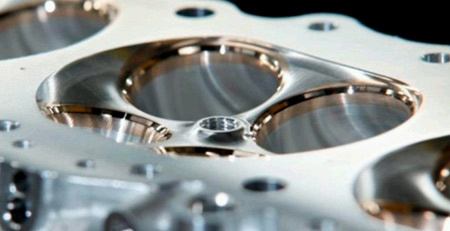The effect of valve size
There can be little doubt that the flow bench is a useful piece of equipment. They can be found everywhere, from the workshops of those who tinker with engines for a hobby to some of the top engine manufacturers in the world. Those with large financial resources and great faith in CFD can perhaps manage well enough without a flow bench - indeed, CFD can tell us much more about port flows than a flow bench ever could. Both these tools are excellent in their own way. Anyone with a little common sense and some understanding of the subject can work a flow bench and get some answers; CFD requires expensive computers, software and experts to run them.
However, one fact the flow bench and CFD will confirm for us is that bigger holes will flow more air for a given pressure difference. Therefore, they will always tell us that bigger valves, used with correspondingly large valve seats, will flow more air. The ability of an engine to flow and, most important, trap air is a measure of its potential to produce power. To a given mass flow of air we meter a set amount of fuel in a set ratio, and the amount of fuel and air trapped in the engine dictates the amount of energy that will be liberated by combustion.
What people have found though, at great expense, is that the flow bench and steady-state CFD are not the best tools for sizing valves. Unfortunately for design and development engineers alike, the best method for those without huge computing power at their disposal is to build engines and run them on the dyno. If you were to undertake this painstaking and expensive development work, you would find a peak in performance, either side of which there would be a drop-off in output. One hugely experienced engineer once remarked to me, on the subject of designing and developing fixed-displacement engines, that it would be less of a mistake to select the wrong cylinder bore size than to select the wrong valve size. What we can say is that it isn't necessarily the best course of action to squeeze in absolutely the largest valves possible into a given combustion chamber.

One measure that we do have that might help us select inlet valve sizes that are somewhere close to optimum is that of mean flow velocity. This is often referred to as the Lovell factor or 'mean mach index', and there are plenty of references to this in Race Engine Technology magazine where sufficient information has been possible to undertake the analysis.
As with other measures of engine design, such as mean piston speed, we find that most race engines, large or small, do not differ hugely in terms of intake mean flow velocity. Those that are a long way outside of the normal mean flow velocity range of 65-75 m/s either have something wrong or the people developing them have taken a very unusual development route. For instance, the Corvette C5R Le Mans 5.97l entry from 1999 had mean inlet valve flow velocity of almost exactly 70m/s. For 2000, displacement was increased to almost 7 litres, and the mean inlet valve flow velocity increased to almost 75 m/s. The last Toyota V8 Formula One engine had a mean inlet flow velocity of 68m/s at peak engine speed.
Bear in mind that the V8 engines had been allowed to run much faster than their current mandated maximum engine speed of 18,000 rpm. During 2006, when engine speeds were not capped, the mean inlet flow velocity at maximum engine speed would have been around 75 m/s. The 7 litre, two-valve-per-cylinder, 24-hour Corvette behemoth and Toyota's beautiful, high-revving, lightweight Formula One engine were similar in at least one respect... .
Fig. 1 - This beautifully machined Formula One combustion chamber houses inlet valves whose sizing appears to share much with some very different race engines
Written by Wayne Ward